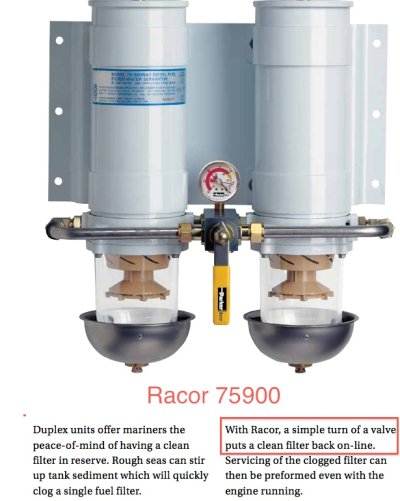O C Diver
Guru
- Joined
- Dec 16, 2010
- Messages
- 12,865
- Location
- USA
- Vessel Name
- Slow Hand
- Vessel Make
- Cherubini Independence 45
Wow! That's impressive. My system, while no where near as impressive, embraces most of the same principles. After my refit, all fuel will be added to the port tank. Polished through a Racor 1000 with 30 micron filter and transfered as needed to the starboard tank. Engine and genset both draw off the starboard tank only. Engine has a dual Racor 1000 system and the genset a smaller Racor separator. Either tank can be polished and fuel can be transfered in either direction. In an emergency, fuel can be added from a fuel dock to the starboard tank, and in an emergency the tanks can be gravity equalized (without a pump). As the tanks are each 350 gallons and the engine has a maximum fuel consumption of only 6 gph, I don't envision having to do fuel management while under way. Wished I could have incorporated a day tank into my engine space, but just couldn't find a place for the appropriate size tank.Here's our set-up.
The first photo is the fuel distribution panel. In the foreground is the Supply & Return manifolds (Return above, Supply below). In the background in the corner, is the fuel Transfer manifold. We have 5 fuel tanks which hold a total of 2500 gals of diesel. One of the tanks is used as a dedicated Day Tank (this one is 300 gals). Any fuel that enters the Day Tank is first sent through a 2 micron fuel polishing Racor. (The tall one to the right in the second photo). All 4 engines and one diesel heater take polished fuel from the Day Tank only. The 2 Racors to the left are dedicated to the main engine, via a Dual-Racor arrangement. (notice the vaccuum gauge inbetween the racors). The third Racor in the picture filters fuel for the Gen-sets & wing engine. All Racors are 10 micron, apart from the 2 micron fuel polisher.
So, the fuel is polished and sent to the Day Tank. From the Day Tank, they pass through a 10 micron Racor, and then onto the On-engine filters. So far, this set-up has served us well.
Having a robust fuel filter / management system goes a long way to making my mid-transit head space right. While I do appreciate the simplicity of the spin-on's, I prefer the visual piece-of-mind of the clear bowl Racors more. I can lift out the racors and clearly see what crap has been caught, but with my spin-on (On-engine) filters, I try to look, but end up just tossing them summizing they've done their job and it's 'time' for the change.
Ted





